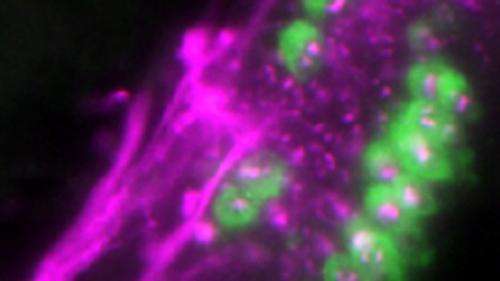Innate barometer in birds evolved from ancient fish sense organ

(Phys.org)—Latest research shows that the 'paratympanic organ' (PTO) – the innate barometer in the middle ear of birds – evolved from a fish sense organ that detects jaw movement.
The work, published in Nature Communications, sheds new light on the evolutionary trajectory of sensory systems after tetrapods left the oceans and moved onto land.
The 'spiracular organ' found in cartilaginous fishes (sharks and rays) and some bony fishes (including gars, sturgeons and lungfishes) is structurally similar to a bird's PTO and located in the same position within the head, that is, in the wall of the 'spiracle' – the first gill slit – from which the middle ear cavity of all land vertebrates evolved.
Both organs contain motion-detecting hair cells, like those in the human inner ear used for hearing and balance. Ear drum movements in birds, and jaw movements in fish, respectively distort the PTO and spiracular organ, triggering the hair cells.
It has been proposed that birds use the PTO to detect air pressure, assisting with rapid changes in altitude. The organ is most complex in fast flyers such as swifts.
By combining gene expression with fate-mapping techniques in chicken embryos, scientists have been able to determine that the PTO stems from a unique 'placode' whose existence in birds had not previously been suspected. Placodes are specialised patches of thickened embryonic skin from which sense organs develop.
The research by Dr Paul O'Neill was started in Dr Clare Baker's lab in the Department of Physiology, Development and Neuroscience at the University of Cambridge and completed in Dr Raj Ladher's lab at the RIKEN Center for Developmental Biology in Kobe, Japan.
The avian PTO was first described in 1911 by Giovanni Vitali at the University of Siena. After initial excitement, which led to Vitali being nominated for the 1934 Nobel Prize in Physiology or Medicine, its existence was largely forgotten or ignored.
"The discovery of this placode removes the only obstacle to accepting an evolutionary relationship between the avian PTO and the spiracular organ," said Baker.
"The PTO is also found in alligators and has been reported in the tuatara – the sole living representative of an ancient reptilian lineage distinct from lizards and snakes. Although its function in these species is unknown, it could relate to jaw movement. It is not clear why the PTO was lost in the other amniote lineages – mammals, turtles, lizards and snakes – but the PTO's function is likely to have been modified in birds for detecting air pressure during flight."
"It will be interesting to use modern molecular techniques to determine whether the PTO placode starts to develop in mammals, even if the organ itself is not found."
The UK research was funded by the BBSRC and the work in Japan was funded by the Japan Society for the Promotion of Science (JSPS) and RIKEN.
Previous work on sense organ development from Baker's Cambridge lab, published in Nature Communications and Development, showed that the last common ancestor of all vertebrates with jaws (that is, all living vertebrates except lampreys and hagfishes) had a placode-derived system of electrosensory organs for detecting changes in the local electric field, used for hunting live prey.
Journal information: Nature Communications
Provided by University of Cambridge



















